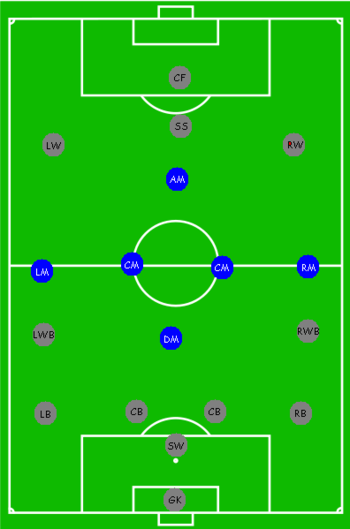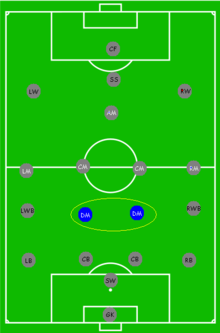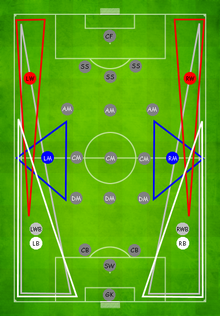Midfielder
--90.203.114.86 (talk) 23:46, 21 June 2008 (UTC)--90.203.114.86 (talk) 23:46, 21 June 2008 (UTC)
This article needs additional citations for verification. (June 2008) |
For the Australian Rules position, see Midfielder (Australian Rules).

In association football, a midfielder is a player whose position of play is midway between the attacking strikers and the defenders (highlighted in blue on the diagram). Their main functions are to dispossess (tackle) the opposing team, to retain possession of the ball, and to feed it to the strikers, and perhaps, to score as well.[1] Some midfielders play a more defensive role, while others blur the boundaries between midfielders and forwards. The number of midfielders a team uses during a match may vary, depending on the team's formation and each individual player's role. The group of midfielders in a team is called the midfield.
More complete midfielders require a number of skills on top of fitness: they tackle, dribble, shoot, distribute and pass during any match. Most managers field at least one central midfielder with a marked task of breaking up opposition's attacks while the rest are more adept to creating goals or have equal responsibilities between attack and defence. At either side of the pitch a manager can a field a right or left midfielder, who are used equally for both attack and defense, or a winger, a more attacking player used primarily for attack.
In essence, a good midfield must possess the ability to be combative whilst also being creative. A good striker without midfield support could lack attacking chances, while a defence likewise could be severely tested. Because they occupy the most influential parts of the pitch, midfielders are perhaps more likely to influence the outcome of a match than other positions,[2] especially if they have vision for a good pass or ability to score.
Midfielders typically exhaust the most energy during a match due to the distance they cover on a pitch, as at times they can be called back into defence, or required to attack with the strikers.[1]
Central midfielders
Central midfielders play several roles on the field of play, and are probably the most important in terms of setting up attacks. Their position enables them to have an all-round view of the match, and as most of the action takes place in and around their area of the pitch, midfielders often exert the greatest degree of control over how a match is played. This section of the field is often known as a team's "engine room", because great teams rarely succeed without skillful, commanding central midfielders.
Defensive midfielder

A defensive midfielder or a holding midfielder is a central midfielder who is stationed in front of the back defenders for defensive reasons, thus "holding back" the freedom of the opponents to attack.[3] This specialist midfielder's responsibilities are to defend against or tackle the opposing team and hold his defensive position, safely distributing the retrieved ball to more attack-minded players.
This is possibly one of the newest roles in modern football tactics. It is often likened to an evolved version of the old-school sweeper.
The defensive midfielder position is also referred to in Brazilian Portuguese as "volante" and in South American Spanish as "volante de marca" (Spanish & Portuguese for "Rudder" or someone who gives direction), and in Portugal as a "trinco" (meaning "lock"). Most Brazilian teams deploy at least one "volante" in their team, including the Brazilian national team who have fielded defensive midfielders, such as 1994 World Cup winning team captain Dunga.
Accomplished defensive midfielders playing today include Claude Makélélé,[4] Gennaro Gattuso,[5] and Javier Mascherano.[6]
Deep-lying playmaker
Some players prefer to set up an attack from a withdrawn position, and are often coined deep-lying playmakers, mainly because of their ability to spread play and dictate the game from a withdrawn position. Despite their deep role, they are not classed as defensive midfielders as tackling and defense are not the main function of their roles - they may have to be supported by a holding midfielder.
Players in this mould include Michael Carrick,[7] Andrea Pirlo[8] and Xavi.[9]
Attacking midfielder

An attacking midfielder is any midfielder who is stationed in a more advanced midfield position to assist goalscoring.[2] The attacking midfielder is an influential position and requires the player to possess good technical abilities, an eye for a pass, shooting, running, and dribbling skills.
Playing in a very advanced central midfield role just behind the strikers is sometimes known as "playing in the hole", although this term can also be used to describe a deep lying forward. This specialist midfielder's main role is to act as the offensive pivot of the team, to create goal-scoring opportunities for his team mates, and perhaps to score himself. He may be referred to as the playmaker.[3]
Francesco Totti,[10] Paul Scholes,[11] Juan Roman Riquelme[12] and Kaká[13] are attacking midfielders widely considered to be among the best today.
"Box-to-box" midfielders
The term 'box-to-box' player is often used to refer to the most dynamic all-round/complete midfielders, who provide both defensive and attacking prowess.[14] The most versatile of players, they typically possess exceptional stamina and are usually skilled at tackling, passing, shooting and keeping possession.[2]
Notable examples include Roy Keane,[15] Patrick Vieira,[16] Steven Gerrard[17] and Michael Essien,[18] all capable of making defensive and attacking contributions from "box to box" - their own penalty area and the opposition's.[14]
Wide midfield positions
Winger

A winger is a midfielder who is stationed in a wide position near the touchlines.[19] Wingers such as Stanley Matthews or Jimmy Johnstone used to be classified as forwards in traditional W-shaped formations, and were formally known as "Outside Right" or "Outside Left," but as tactics evolved through the last 40 years, wingers have dropped to deeper field positions and are now usually classified as part of the midfield, usually in 4-4-2 or 4-5-1 formations (but whilst the team is on the attack, they tend to resemble 4-2-4 and 4-3-3 formations respectively).
It is a winger's duty to beat opposing full-backs and to deliver cut-backs or crosses from wide positions.[3] They are usually some of the quickest players in the team and usually have very good dribbling skills as well.[20] Sometimes, they are also expected to cover/attack the central area, as well as switch flanks. Technically gifted wingers are able to dribble infield, and by means of using a plethora of tricks, pass defenders and shoot or set up a teammate.
In recent years there has been a trend of playing 'unorthodox' wingers - wide men stationed on the 'wrong' side of the pitch, in order to enable them to cut inside and shoot on their stronger foot. One example of this is the tactical use of Robin van Persie by Netherlands coach Marco van Basten at the 2006 World Cup; the Netherlands played with a front three of Arjen Robben wide left, target-man Ruud van Nistelrooy in the middle and the left-footed van Persie wide right. Such deployment usually leads to players being referred to as playing 'from the right' rather than 'on the right'. Similarly, former Newcastle United manager Sam Allardyce, who favours a front three, started the 2007-08 season with right-footed James Milner playing from the left, Mark Viduka as a centre forward and left-footed Obafemi Martins from the right, whilst at Manchester United it is common for right-footed Cristiano Ronaldo and left-footed Ryan Giggs to switch sides continually throughout a match.
Notable orthodox right-wingers currently playing include Joaquín and Mauro Camoranesi. Orthodox left-wingers include Florent Malouda, Vicente Rodríguez and Ryan Giggs.
'Unorthodox' right-wingers (left-footed) include Lionel Messi and Shunsuke Nakamura. Unorthodox left-wingers (right-footed) include Robinho and Ronaldinho.
Contemporary players who can play from either side include Simão Sabrosa, Franck Ribéry and Cristiano Ronaldo. In the 1970s, one of the foremost practitioners of playing from either flank was the German winger, Juergen Grabowski, whose flexibility helped Germany to third place in 1970, and a championship in 1974.
Right/left midfielders
Traditionally wingers were purely attacking players who hugged the touch line and were not expected to track back and defend. This began to change around the time of the 1966 World Cup, when England manager Alf Ramsey led a team without natural wingers to the championship. This team was known as the "Wingless Wonders" and led to the modern 4-4-2 formation.[21]
This has led to most modern wide players having a more demanding role in the sense that they are expected to provide defensive cover for their full-backs and track back to repossess the ball, as well as provide skillful crosses for centre forwards and strikers.[19]
A wide player who plays in a deeper, more defensive role would not be classed as a winger, though there is some crossover between the terms.[3] An example of this would be David Beckham, who plays as a right-midfielder but does not rely on pace and trickery to dribble past opponents to cross from the byline, rather he uses his passing ability to set up attacks.
Even more demanding is the role of wing-back, where the wide player is expected to provide both defence and attack.[22] As the role of winger can be classed as a forward or a midfielder, so this role blurs the divide between defender and midfielder.
See also
References
- ^ a b "Positions guide: Central midfield". BBC Sport. Retrieved 2008-06-21.
- ^ a b c "Positions in football". talkfootball.co.uk. Retrieved 2008-06-21.
- ^ a b c d "Football / Soccer Positions". Expert Football. Retrieved 2008-06-21.
- ^ "Doing a Makelele - so good they named it after him". Telegraph. 2007-02-24. Retrieved 2008-06-21.
- ^ Hylands, Alan. "Gennaro Gattuso". World Soccer. Retrieved 2008-06-21.
- ^ Hylands, Alan. "Javier Mascherano". About.com. Retrieved 2008-06-21.
- ^ "Michael Carrick". ESPN. Retrieved 2008-06-21.
- ^ "Andrea Pirlo". 123football.com. Retrieved 2008-06-21.
- ^ "Xavi One Of The Best - Aragones". goal.com. 2008-06-10. Retrieved 2008-06-21.
- ^ "Francesco Totti". 123football.com. Retrieved 2008-06-21.
- ^ Jackson, Jamie (2008-05-18). "Simply the best". The Guardian. Retrieved 2008-06-21.
- ^ Cowley, Jason (2006-06-18). "Lonesome Riquelme is the go-to man". The Observer. Retrieved 2008-06-21.
- ^ "Kaka able to see beyond dollar signs". wfp.org. Retrieved 2008-06-21.
- ^ a b "Box to box Bowyer". BBC Sport. 2002-04-29. Retrieved 2008-06-21.
- ^ "'He made them an extension of his own will'". The Times. 2005-11-18. Retrieved 2008-06-21.
- ^ Lawton, Matt (2007-09-05). "Neville's shirt belongs to me, says Micah". Daily Mail. Retrieved 2008-06-21.
- ^ Smith, Martin (2007-12-27). "Steven Gerrard saves Rafa Benitez's blushes". The Telegraph. Retrieved 2008-06-21.
- ^ "The verdict on Essien". BBC Sport. 2005-08-17. Retrieved 2008-06-21.
- ^ a b "Positions guide: Wide midfield". BBC Sport. Retrieved 2008-06-21.
- ^ "What makes a good outside midfielder (winger)". Retrieved 2008-06-21.
- ^ Galvin, Robert. "Sir Alf Ramsey". nationalfootballmuseum.com. Retrieved 2008-06-21.
- ^ "Positions guide: Wing-back". BBC Sport. Retrieved 2008-06-21.
